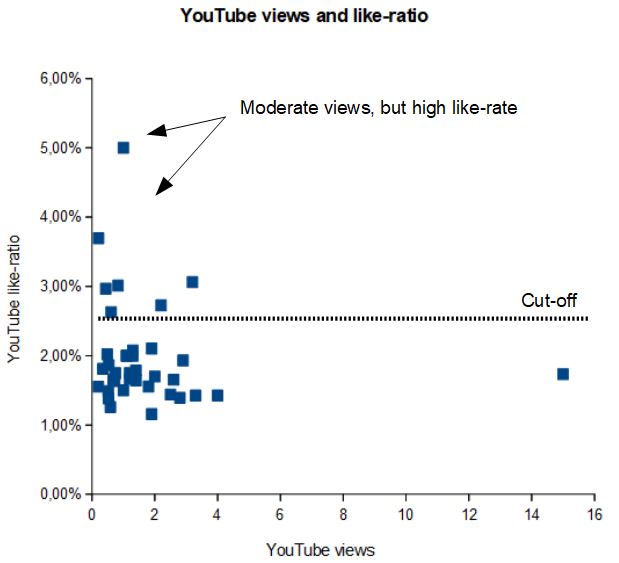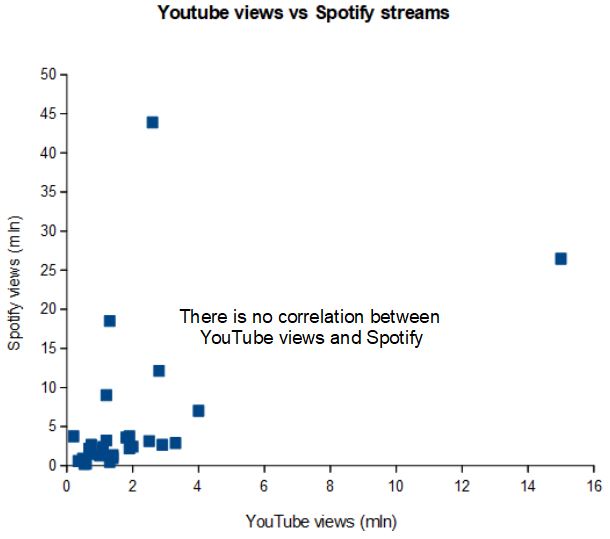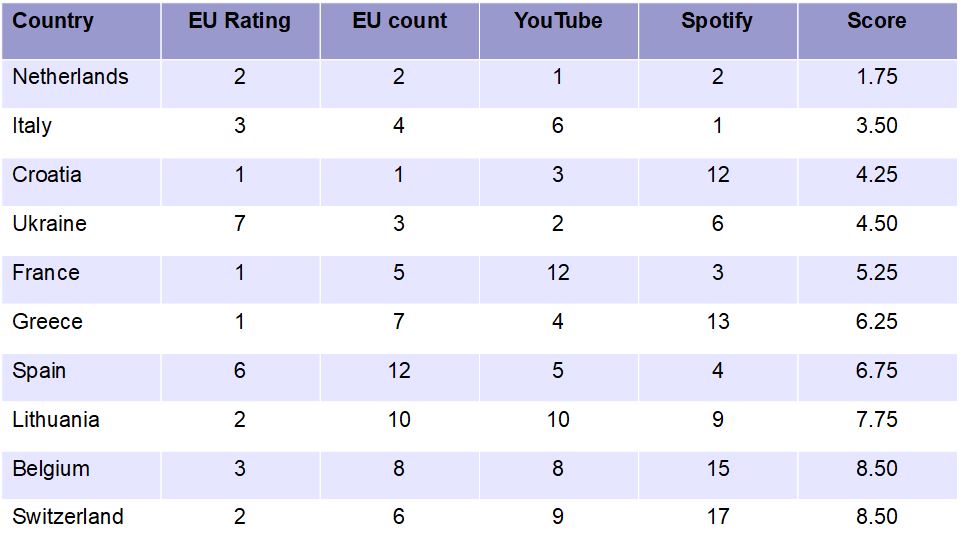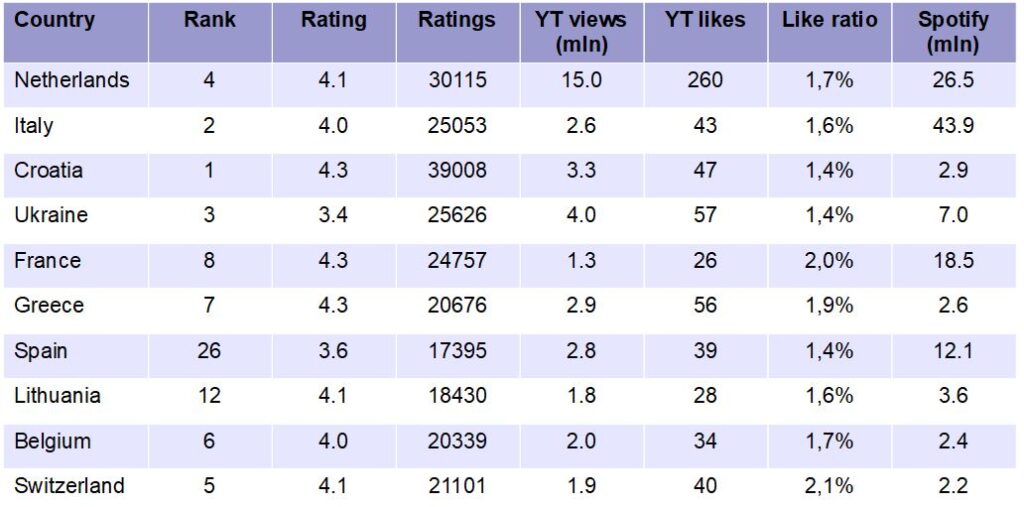Author: Berry Matijssen
Reading time: 5m:31s
Updated: 14 April 2024
Index
1. The Eurovision Song Contest 2024
2. The approach to determine the ranking of the best song
3. The relationship between YouTube views and like-ratio
4. Correlation of the engagement on the Eurovision site, YouTube and Spotify
5. The final prediction for Eurovision 2024
1. The Eurovision Song Contest 2024
Every year the Eurovision Song Contest is organized and is full of entertaining performances and often with a surprising winner. The voting process consists of two parts: a professional jury and a public vote. Often both scores do not match, making it difficult to predict the favourite. However, an attempt can be made using different online media sources and, as can be seen in the title, The Netherlands is the predicted winner. This is followed up by Italy and Croatia.
2. The approach to determine the ranking of the best song
To determine the popularity of the song from each participating country, three sources are used. The first one is the website of Eurovision that holds a rating and a rating count. Secondly is YouTube, which has the number of views and likes of the video clip. Third is Spotify and has only the count of streams.
The method for calculating the final ranking is straightforward. For each score the countries get ranked and the one on top is assigned a 1, the second a 2, etc… When the same score is obtained, both countries obtain the same rank and there are no gaps afterwards. The reason for this approach is rate equal where possible and not punish the following ones by creating gap. If this was not applied, a single poor score could cause it to drop completely.
Two adjustments are made to this approach. Countries that have a high like-rate on YouTube were excluded, as it appears there is an artificial boost to their score. This will be explained below. The count of likes on YouTube is excluded from the ranking as, in general, it appears to correlate with the view count. Therefore, it has limited value and the risk is that it could weigh YouTube too strongly compared to the other scores. This will be explained later as well.
With the final four rankings available, an average rank is determined and the one on top is predicted to be the winner of Eurovision 2024. All data were selected on the 1st of April, so there will be a small delay between data collection and the publication date. Some checks were performed at the time of publication with the current data and despite the number having changed, it appears that the ratio between scores hold up. As with any prediction, future developments can have an impact and change the ranking.
3. The relationship between YouTube views and like-ratio
A remarkable relationship exists between YouTube views and likes for the same video. It is a better approach to look at the ratio between both values, as this allows videos to be compared. When views and like-ratio are plotted against each other, it can be seen that there is no clear relationship between both. In other words, more views do not lead to a higher like-ratio. For most video’s a like-ratio between 1 and 2% is considered normal.

More remarkable are the videos with a high like-ratio, but are moderately streamed. It could be suggested that there is some activism going on to promote the song. A good example is Israel, which shows a high amount of views on YouTube and a high like-ratio, but performs poorly on Spotify. The audience for Spotify is much broader, as it has the highest participation (streams) compared to the other measurements used in this study. Therefore, it can be suggested that a high-like ratio on YouTube means that a selected audience tries to influence its result, but this audience cannot necessarily influence the real vote in the same way on the day of the song contest.
Noticeable is that countries with a high like-ratio are not suggested as favourites of ending up in the top 5. Therefore, the countries with a YouTube like-ratio of more than 2.5% are excluded as they could artificially negatively influence the ranking of other participants. This exclusion does not influence the outcome for these countries themselves, as they are not part of the favourite contenders for winning Eurovision. It must be noted that this approach carries a significant risk, as only after the contest has been finished these countries can be actively excluded.
4. Correlation of the engagement on the Eurovision site, YouTube and Spotify
A check was performed to establish if there was a correlation between the numbers generated by YouTube and Spotify. In general, when multiple data values show a strong correlation then a certain feature could be weighted too strongly, thereby removing the influence of an unrelated value. The reason for using different sources is that different measurements on the popularity of a song are required, and therefore it should be expected to see differences between data sources. This does not mean that a single song should rank differently in all media sources. Ideally, a song is the best when it is ranked highly in all media services and therefore, has the best chance of being the winner.
A plot of YouTube views against Spotify streams shows there is a clear difference between them. As an addition check, a correlation matrix was generated (not shown) and confirmed that all data sources were not correlated. However, there was a correlation between YouTube views and likes as in the previous step, videos with a high like-ratio were excluded.. Therefore, only the YouTube views are included.

5. The final prediction for Eurovision 2024
The results show that The Netherlands will finish first, Italy second and Croatia third. This is different from what the odds predict, as they ranked Croatia first at the time of data collection, but this has now changed to Switzerland being ranked highest. The reason Croatia does not rank first in this prediction is the low stream count on Spotify, which represents a poor performance. This could indicate that with a large audience, the song is not so popular. The prediction of Switzerland is surprising, as in none of the rankings it comes up on top, but always ranks as a good average. Italy finished in most ranks just behind the Netherlands, making it a strong contender. Where is does outperform is the Spotify streams. It has almost double than the Netherlands and has the most streams of all countries. This is an indication that the audience could prefer this song, and one could argue that its artistic performance is better than that of the Netherlands. Still, the song that ranks highest is The Netherlands, ranking in any score first or second. Combine this with a highly entertaining artist and a catchy tune, the popularity found in the different media channels could turn it into reality and a win at the Eurovision Song Contest.
StoCoTo.com is looking forward to Joost Klein, Angelina Mango, Baby Lasagna and all participants to put up a great show and wishes them all the best with the Eurovision Song Contest of 2024.

The final rankings (above) and the media performance used to obtain this result (below).

Are you interested in learning more about StoCoto.Com. Visit the AEX or Dow Jones index to see our stock market analysis. Or maybe read an article on the Money Flow Index or Relative Strength Index to become familiar with technical analysis.
